Fish Identification in the field / market:
Freshwater Fishes of India (Banda, UP):
The sorting of some fishes in the field / fresh market catches has / had been made on the basis of the presence of considerably long filamentous extensions of skin around mouth (= barbels) and absence of scales on the body (smooth skinned).
They have been placed under ‘Lot 11’, labeled as ‘CATFISHES’.
Fish Identification in the field / market:
Some important diagnostic features of ‘CATFISHES’ [Order: Siluriformes], to be segregated ahead, need a special attention viz.,
Ø Barbels:
As one of the most diagnostic features, all Catfishes possess long or short, paired filamentous extensions of skin around the mouth, called as ‘Barbels’. Maximum 4 pairs of barbels, viz., 1 pair Nasal or Rostral barbel, 1 pair Maxillary barbel and 2 pairs of Chin or Mandibular barbels (i.e., outer mandibular and inner mandibular) are noticed.
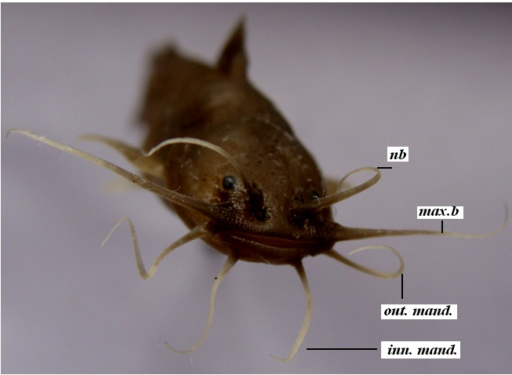
A catfish (Front view) Showing 4 pairs of barbels viz., Nasal (or Rostral) barbel [nb], Maxillary barbel [max. b.], Outer Mandibular [out. mand.] and Inner Mandibular barbel [inn. mand.].
Ø Adipose Dorsal Fin:
In addition to a Rayed Dorsal Fin, in most catfishes there is another dorsal fin behind the first one. It is only a fleshy (or leathery) vertical extension of skin, called Adipose Dorsal Fin, exhibiting some prominent Genus/Species specific features (may be colour marking or size).
Ø Adhesive Apparatus:
If some catfishes from fast flowing rocky streams are viewed ventrally at the chest region, there will be found a special structure with folded/pleated skin. This is called as adhesive apparatus, used for clinging to the stones, rocks or boulders.
· Habitat preferences by Catfishes:
Varied kind of habitats are preferred by catfishes, ranging from fast turbulent to slow running, weedy or marshy stretches with rocky, bouldery, pebbly, sandy or muddy beds. Also, they have been successfully living in aquaculture ponds /reservoirs. As will be seen after segregation, their body is more or less suited to special living conditions with special adaptations viz., shape of body, presence of adhesive structures, spines in the dorsal or pectoral fins, accessory respiratory organs etc.
COMMON CATFISHES TO BE IDENTIFIED IN MARKET CATCHES
It is quite interesting to note that in the span of more than 40 years, some CATFISHES are regularly being brought to and sold in the market (as observed on 16.12.2019 in Fish Market of BANDA District, Uttar Pradesh, India). River Ken, flowing through the district, the most important tributary of Yamuna; is main fishing ground. Besides, irrigational channels, aquaculture ponds and
reservoirs are also the sources of market supply.
The following photograph shows an assemblage of Catfishes (numbered 1 – 5), exhibiting such diagnostics as they can be identified with certainty at least up to Generic level (or up to species level, too).

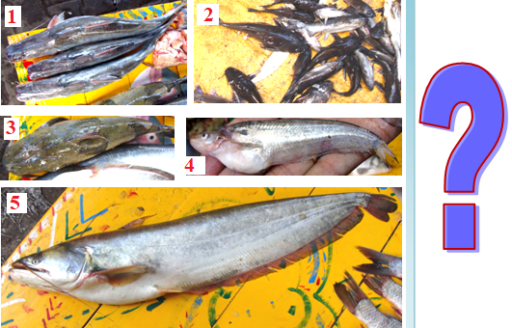
1. Head depressed, snout spatulate (chisel-like) and the adipose dorsal fin with a black spot at the posterior end of its base.
.…. Sperata (= Aorichthys) sp. may be.
2. Head broad and depressed, dark greenish along the dorsum, purplish-grey on the flanks, blackish-grey-white along the abdomen; pectoral fin strongly denticulated on both the edges. ….. Rita sp. may be.
3. Head broad and flat, colour yellow ochre-brown with darker bands: one from the rayed dorsal to behind the pectorals and another from the adipose dorsal to the anal; whip-like prolongations on the upper caudal lobe and pectorals. …. Bagarius sp. may be.
4. Anal fin long, cleft of mouth wide not extending to the anterior border of eye; bright silvery with purplish hue, prominent shoulder spot behind the opercle. ….. Ompok sp. may be.
5. Anal fin long, cleft of mouth wide extending up to behind eyes; dark slate-grey along the back, silvery-grey on the sides. …..Wallago sp. may be.
SEGREGATION OF SPECIES
1. Head depressed, snout spatulate (chisel-like) and the adipose dorsal fin with a black spot at the posterior end of its base. .…. Sperata (= Aorichthys) sp. may be.
The Genus – Sperata (Order – Siluriformes, Family- Bagridae) showing the above referred characteristics (as observed in the market catches), belongs to 2 species viz., Sperata seenhgala and Sperata aor, maxillary barbels and the adipose dorsal being the most sharply segre.gating diagnostics, characterized as under:
· Body elongated (14.0 – 43.0 cm). Head depressed. Snout spatulate (chisel-like). Mouth wide, upper jaw being longer. Eyes elliptical. Barbels 4 pairs, the maxillary longest and reaching up to opposite the end of rayed dorsal or up to pelvics, outer mandibulars to base of pectorals and nasals to middle of the orbit. Rayed dorsal spine rugose externally and indistinctly serrated internally. Adipose dorsal as long as the base (about 1.1 times) of the rayed dorsal and with a black spot at the rounded posterior end of its base. Dark grey along the dorsum and silvery grey on the flanks and more grey-white along the belly.
….. Sperata seenhgala
(= Mystus seenghala, Aorichthys seenghala)
Market name: Tengan
· Body elongated (15.0 – 45.0 cm). Head depressed. Snout spatulate (chisel-like). Mouth wide, upper jaw being longer. Eyes elliptical. Barbels 4 pairs, the maxillary longest and reaching up to base of caudal fin, outer mandibulars to base of pectorals and nasals to middle of the orbit. Rayed dorsal spine rugose externally and indistinctly serrated (with 7-8 teeth) internally. Adipose dorsal longer (about 1.6 times) than the base of the rayed dorsal and with a black spot at the slightly incurved posterior end of its base. Dark grey along the dorsum and silvery grey on the flanks and more grey-white along the belly.
….. Sperata aor
(= Mystus aor, Aorichthys aor)
Market name: Tengan
NOTE: Of these two species Sperata seenhgala is more frequent in market catches.
Photographs of Sperata sp.a
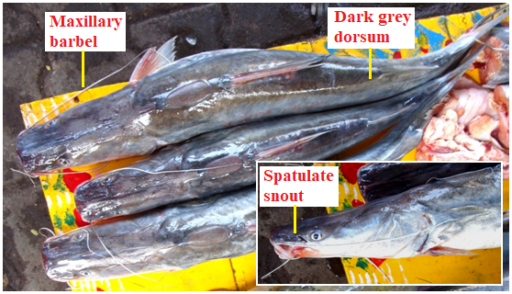
Assemblage of Sperata seenghala in market catch.
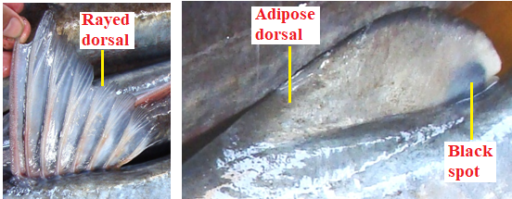
Sperata seenghala: Rayed dorsal and adipose dorsal fins enlarged, showing spiny, Ist ray of the Rayed Dorsal fin rugose externally and finely serrated internally and adipose dorsal, almost rounded posteriorly and bearing a diagnostic black spot at posterior base.

Sperata aor: Mark two important diagnostics as compared to Sperata seenghala viz., quite long maxillary barbel, reaching up to base of caudal and a long-based adipose dorsal, incurved posteriorly and bearing a diagnostic black spot. [Photo.: From Thesis of SKG, 1975 – 1982].
2. Head broad and depressed, dark greenish-brown along the dorsum, purplish-grey on the flanks, blackish-grey-white along the abdomen; pectoral fin strongly denticulated on both the edges. ….. Rita sp. may be.
The Genus –Rita (Order – Siluriformes, Family- Bagridae) showing the above referred characteristics (as observed in the market catches), belongs to only 1 species viz., Rita rita, characterized as under:
· Body stockily-built (12.0 – 22.0 cm). The surface of the dorsum between the head and the dorsal fin as well as the shield above the pectoral is bony and granulated. Head broad and depressed. Eyes subcutaneous. Barbels 3 pairs; nasals being small, broad-based and falling short to the anterior border of eye; maxillary pair longer and reaching to or slightly beyond the gill opening and mandibulars reaching to or a little before pectoral base. Dorsal and pectoral fins with stout, hollow bony spines, the dorsal one being serrated on the inner, upper edge only whereas that of pectoral spine is horizontally spread and strongly dentate on both the edges, more strongly on the inner. Outer pectoral indentations (about 40 – 45) are retrorse (directed backwards) whereas those of inner (about 35 – 40) are antrorse (directed forwards). Dark greenish-brown along the dorsum, purplish-grey on the flanks and blackish-grey-white along the abdomen.
….. Rita rita
Market name: Gigra
NOTE: Most commonly-sold live in the market, it is quite a hardy fish and often seen retaining vitality for a long time after being kept out of water (or packed in wet gunny bags). Fish sellers keep them live by sprinkling water on them, off and on.
Photographs of Rita rita
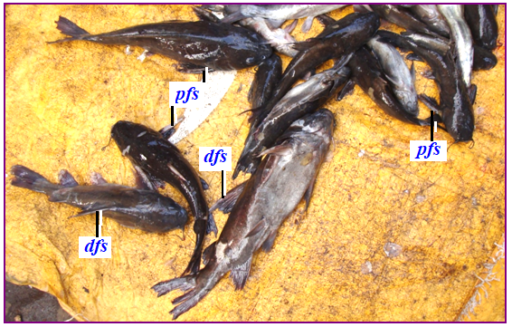
An assemblage of Rita rita in market catches: Mark dark greenish colouration along the dorsum, purplish-grey on the flanks and blackish-grey-white along the abdomen and most diagnostic dorsal fin spine (d.f.s.) and pectoral fin spine (p.f.s.)
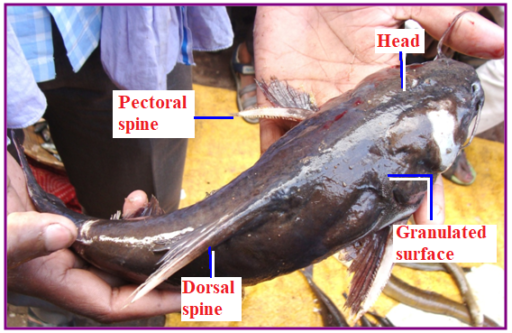
Rita rita: One specimen enlarged showing broad, depressed head; bony and granulated surface of the dorsum between the head and the dorsal fin as well as the shield above the pectoral fin; pointed, hollow dorsal spine; denticulated, horizontally spread pectoral spine and dark greenish-brown colouration along the dorsum.
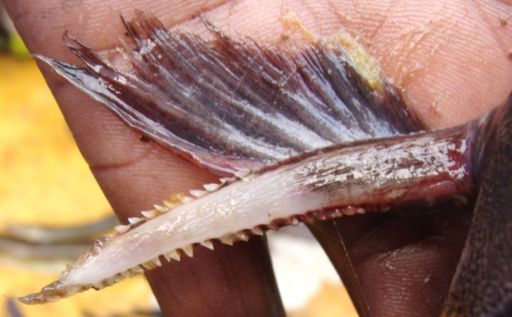
Rita rita: Horizontally-spread, strong, pectoral spine enlarged; showing outer retrorse (about 40-45) and inner antrorse (about 35 – 40) teeth.
3. Head broad and flat, colour yellow ochre-brown with darker bands: one from the rayed dorsal to behind the pectorals and another from the adipose dorsal to the anal; whip-like prolongations on the upper caudal lobe and pectorals. ….. Bagarius sp. may be.
The Genus – Bagarius (Order – Siluriformes, Family- Sisoridae) showing the above referred characteristics (as observed in the market catches), belongs to only 1 species viz., Bagarius bagarius, characterized as under:
· Body elongated (16.0 – 50.0 cm), broader anteriorly but tapering gradually towards tail. Head broad and depressed. Skin rough and granulated along dorso-lateral sides, the dorsal surface of head being bony and highly granulated. Mouth crescentic; upper jaw being longer, the sharp villiform teeth visible when viewed from ventral side. Eyes small, elliptical, subcutaneous. Barbels 4 pairs; maxillary broad-based and extending beyond pectoral base, nasals very short, erect and are the prolongations of a membranous fold separating the nostrils. Pectoral and caudal fins with whip-like prolongations; the prolongation of upper caudal lobe being quite longer. Colour yellow ochre-brown with darker bands; one from the rayed dorsal to behind the pectorals and another from the adipose dorsal to the anal fin.
….. Bagarius bagarius
Market name: Lambhar or Gonch
Photographs of Bagarius bagarius
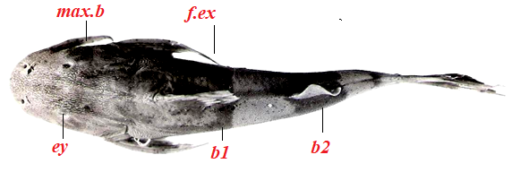
Bagarius bagarius: Dorsal view; showing rough skin and granulated, broad and depressed head; small subcutaneous eyes (ey); broad-based maxillary barbel (max.b); filamentous extension on the pectoral fin (f.ex); two prominent dark bands, one from the rayed dorsal to behind the pectorals (b1) and another from the adipose dorsal to the anal fin(b2). [Photo.: From Thesis of SKG, 1975 – 1982].
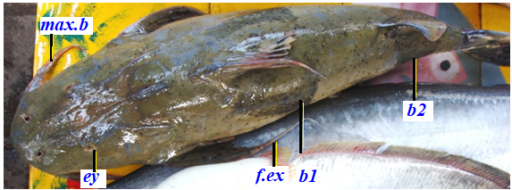
Bagarius bagarius: Dorsal-lateral view; showing rough skin and granulated, broad and depressed head; small subcutaneous eyes (ey); broad-based maxillary barbel (max.b); filamentous extension on the pectoral fin (f.ex); two prominent dark bands, one from the rayed dorsal to behind the pectorals (b1) and another from the adipose dorsal to the anal fin (b2).
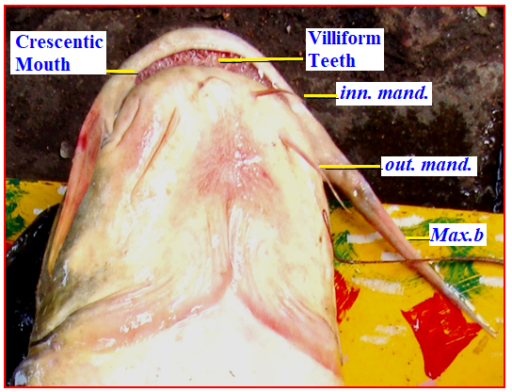
Bagarius bagarius: Ventral view head region; showing crescentic mouth; longer upper jaw (villiform teeth visible on inner side); broad-based maxillary barbel (max.b) and outer and inner mandibular barbels (out. mand., inn. mand).
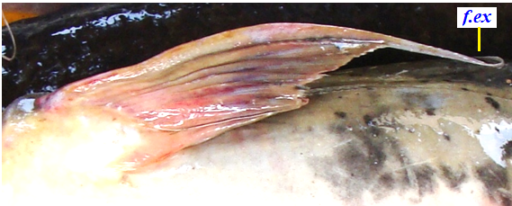
Bagarius bagarius: Pectoral Fin enlarged; showing diagnostic filamentous extension (f.ex).